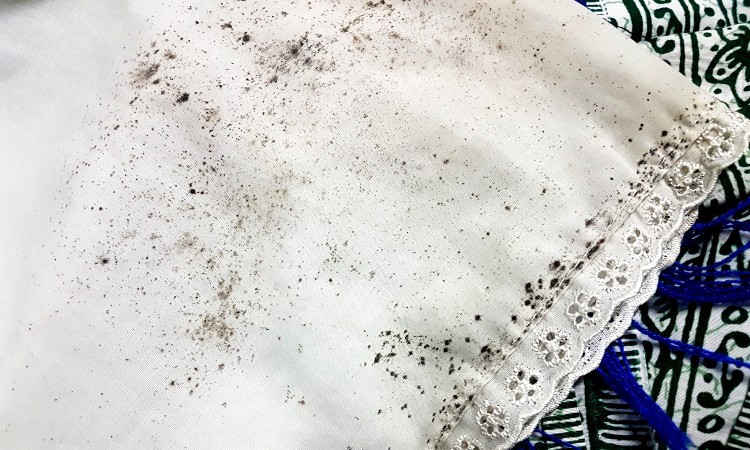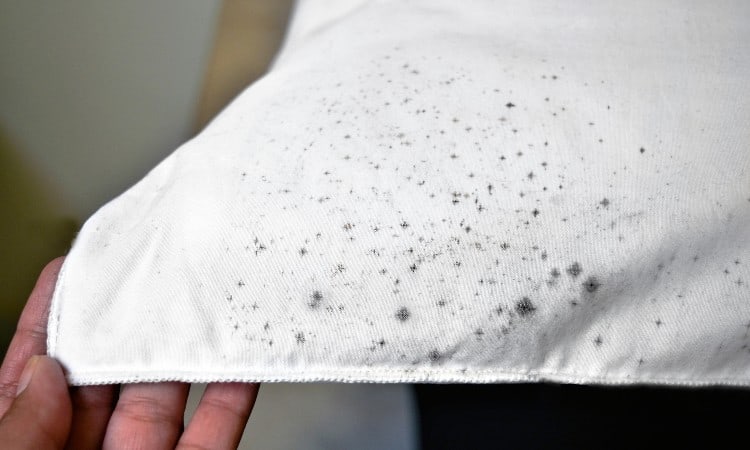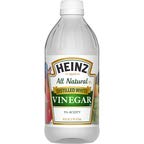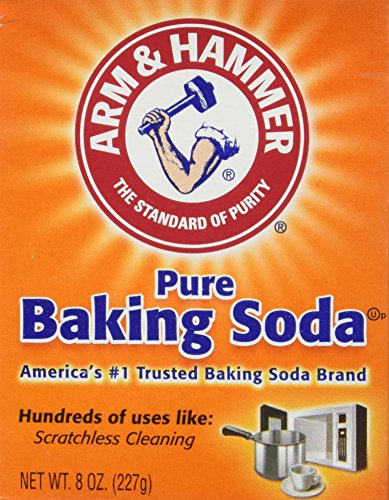If you have ever stored a box of clothes in a basement, you may know the unpleasant surprise of unpacking the box to find black spots growing on your clothing! While health and safety should always come first, you may not have to throw away your mold-stained garments. Instead, you can master a few simple techniques and learn how to remove mold from clothes and fabric.
The best way to remove mold or mildew from clothes and fabric is to apply a bleach solution. For non-washable or colored fabrics, applications of household products such as baking soda, vinegar, hydrogen peroxide, tea tree oil, or borax can safely remove mold. Dry cleaning or washing machine methods can also treat mold.
In this article, you will learn nine methods to remove mold and mildew from your clothing. You will find out how to handle black mold and that moldy smell. Finally, you will get tips on how to prevent your clothes from molding in the first place!

Can Mold Grow On Clothes?
Mold can grow on clothes or any type of fabric quite easily in damp or humid conditions. This happens because mold creates tiny spores that float through the air, seeking a damp place to land. Once a spore finds an inviting, wet surface, it will quickly spread and eat through any organic matter it finds.
In nature, many different kinds of molds play a key role in the life cycle of pretty much everything, allowing decomposition to occur. Mold exists in the air, in the ground, and pretty much all over outside!
Indoors, you will find two dominant kinds of mold that commonly grow on fabric. Black mold grows dangerous mycotoxins and becomes visible even in its early mildew stages. White mold grows more prevalently in homes and on soft furnishings or clothing but is less dangerous.
White mold often looks fuzzy or powdery, while black mold spreads out like scaly lichen.
What Causes Mold on Clothes?
Several factors can cause mold to grow on clothes, but the most common culprit is clothes left wet or damp. If you often pile up a mound of dirty laundry, you might get mold growing on a damp towel or a wet soccer uniform left in a pile too long. Clean clothes that didn’t dry on the line or in the dryer can also mold easily.
If you live in a humid environment, you may find it harder to combat mold. You may need to find ways to consistently ventilate or cool your house to prevent mildew from growing on clothes and furnishings.
Mold is a kind of fungus that propagates by sending out millions of microscopic spores. These spores seek purchase in a damp and inviting surface rich in fibers, just like clothes, shoes, or household furnishings.
Once spores make a landing in your wet clothes, you will probably notice an odd smell within just a couple of days. You will also see the growth begin to appear on top of the fabric.
Are Mold Stains on Clothes Dangerous?
Mold stains on clothes can be dangerous because spores often cause an allergic reaction in humans. This is especially true for black mold, which can cause serious health conditions if left untreated.
If you have any respiratory issues, you need to stay away from any type of mold, as its spores and toxins can cause coughing, choking, sneezing, and fevers, especially in people with asthma. Certain types of mold have also caused rashes, headaches, and other forms of illness, depending on the sensitivity of the person exposed to the spores.
You should never expose yourself to mold in your clothes or your home! Instead, quickly handle the situation by getting the stain removed or even removing the moldy item.
Mold is also dangerous to many types of clothing because it will eat away any organic matter, such as cotton or wool fibers, in your clothes.
Plus, mold can grow on a wet surface as quickly as within 24 to 48 hours, so you need to keep on top of the wet clothes to prevent this from happening!
The good news is that you will easily spot mold stains on your clothes. The white or black spots grow so fast that you can see them without using a magnifying glass or microscope in no time! You will probably also notice a wet, musty, or earthy scent around these garments.
Early detection is a great way to salvage your clothes with a mold-removal method! If you let the situation get too bad, though, you will need to ditch the stained clothes, as the mold will likely have damaged the fabric by eating at its fibers.
Can You Wash Mold Out of Clothes?
Most of the time, you can wash mold out of clothes, especially if you apply a special treatment first, such as using bleach or another cleaning product. That said, you may find that the mold has damaged the fabric of the garment. You may also have trouble fully getting rid of the mildewy smell.
Simply washing your clothes with detergent probably will not fully remove the problem. It may remove the visible stain, but the stain will just grow back again unless you treat the fabric with a mold-killing solution.
Fortunately, you can find many household and commercial products that kill most types of mold. Bleach is the best-known, but vinegar, borax, baking soda, and even tea tree oil can all kill mold as well!
How to Get Mold Stains Out of Clothes and Fabric: 9 Methods

You can get most mold stains out of clothes by treating the stain with common household and commercial products such as bleach, hydrogen peroxide, or vinegar. You will see visible results almost instantly with any of these methods, letting you know that the treatment successfully kills the mold!
That said, you will want to carefully wash and dry the garment after using any of these treatments. Store it separately from the rest of your clothes and check on it two days later to see if any spores survived to grow back.
If you have any respiratory issues, you may need to discard the moldy garment rather than treat it out of concern for your own safety.
Finally, anyone handling moldy items should take precautions such as wearing gloves and a face mask to avoid breathing in the spores as much as possible.
1. Bleach
 In some cases, bleach acts as an effective mold remover for clothing. This is especially true for white cotton clothes. You should know, though, that opinions are divided on whether or not bleach can entirely remove mold from fabric.Bleach kills mold on hard surfaces very effectively but does not always do a great job on soft surfaces. For this reason, you may want to use the borax method after the bleach method just to be safe.
In some cases, bleach acts as an effective mold remover for clothing. This is especially true for white cotton clothes. You should know, though, that opinions are divided on whether or not bleach can entirely remove mold from fabric.Bleach kills mold on hard surfaces very effectively but does not always do a great job on soft surfaces. For this reason, you may want to use the borax method after the bleach method just to be safe.
On top of this, chlorinated bleach will remove color and damage many colored or black clothes. This means you should only apply chlorine bleach to stains on white clothing.
On the other hand, you can safely use oxygen bleach on most color-fast clothing. Oxygen bleach can also kill mold.
To bleach moldy clothes:
- In a disposable cup, mix one-half cup of water with one-half cup of bleach.
- Wearing gloves, either spread this onto the stained area or use a spray bottle to apply it.
- Allow the bleach to sit for ten minutes.
- Place the garment in your washing machine on a hot water setting. Wash with detergent and additional bleach if the stain still looks bad.
- After washing, inspect the garment for any lingering stains.
2. Without Bleach
If you need to remove mold or mildew from non-bleachable clothing, such as something made of wool, leather, or silk, you will need to try a gentle cleaning method.
First, check the care label inside your garment. If it says “dry clean only,” you should not attempt to remove the stain yourself.
In some cases, you can safely launder delicate fabrics at home, though.
- You can use vinegar on old linens. This should remove the mold without damaging the delicate, natural fabric.
- For old quilts, lace garments, or some silks, try using a fabric restorer like this one.
- In some cases, you can use lemon juice and salt rubbed into stains to remove mold or mildew from wool. Just make sure you rinse the garment carefully afterward!
- To get mold off leather, try soaking a cloth in rubbing alcohol and gently wiping it over the stain.
3. Vinegar
 Vinegar contains acetic acid, which can kill most major types of mold quite effectively! Plus, vinegar is cheap and you probably already have some at home.The simplest way to use vinegar on moldy clothing is to measure two cups of distilled white vinegar into your washing machine. Run a hot water cycle. Then check to see if any stains remain!
Vinegar contains acetic acid, which can kill most major types of mold quite effectively! Plus, vinegar is cheap and you probably already have some at home.The simplest way to use vinegar on moldy clothing is to measure two cups of distilled white vinegar into your washing machine. Run a hot water cycle. Then check to see if any stains remain!
For large or stubborn stains, try soaking the stain using a spray bottle filled with straight vinegar. Let this sit for twenty minutes, and then put the garment in the washer.
Alternatively, you can also combine a vinegar wash with a baking soda treatment for even more effective mold removal.
4. Baking Soda/Baking Soda and Vinegar
 Vinegar kills mold, and baking soda removes smells. Combined, these powerful home remedy cleaning products can handle almost all mold stains in clothing!Please note that while you can safely combine vinegar and baking soda (you will see some bubbling, as you probably remember from a long-ago school baking soda volcano project), you should never combine vinegar with other cleaning products such as bleach. Mixing cleaning products can create poisonous fumes that could make you very ill or even kill you!
Vinegar kills mold, and baking soda removes smells. Combined, these powerful home remedy cleaning products can handle almost all mold stains in clothing!Please note that while you can safely combine vinegar and baking soda (you will see some bubbling, as you probably remember from a long-ago school baking soda volcano project), you should never combine vinegar with other cleaning products such as bleach. Mixing cleaning products can create poisonous fumes that could make you very ill or even kill you!
Most of the time, you can measure one cup of vinegar into the first rinse cycle in your washing machine. Then add one-half cup of baking soda to the second part of the cycle.
In some cases, with really serious stains, you may need to try this method:
- In a disposable cup or bowl, mix one half cup baking soda, one-fourth cup white vinegar, and one-fourth cup water. This should form a sticky, bubbly paste.
- Spread this thickly over the stained area.
- Let the paste dry. This may take an hour or two.
- Use an old toothbrush to scrape away the dry paste.
- Wipe the stained area with a damp paper towel.
- Place the garment in the washing machine and wash using hot water and detergent.
5. Hydrogen Peroxide
 Hydrogen peroxide is a disinfectant that can kill viruses and mold, among other things. It has many cleaning properties and can very effectively remove mold stains from clothes in many cases.The danger of using hydrogen peroxide is that it may bleach colored fabrics. This should not happen on any color-fast clothing, but you should dab a small drop on an inside seam to test the fabric before trying this method.
Hydrogen peroxide is a disinfectant that can kill viruses and mold, among other things. It has many cleaning properties and can very effectively remove mold stains from clothes in many cases.The danger of using hydrogen peroxide is that it may bleach colored fabrics. This should not happen on any color-fast clothing, but you should dab a small drop on an inside seam to test the fabric before trying this method.
- Soak the stained area in 3% peroxide.
- Let the stain rest for ten to twenty minutes.
- Rinse the clothing carefully. Peroxide will not damage your skin, but you do not want to touch the mold or get it on your clothes or household furnishings.
- Finally, wash the garment in hot water in your washing machine.
6. Borax
 Borax does a great job removing mold stains and smells. It acts as a fungicide because when mixed with water, it creates hydrogen peroxide. This reaction destroys mold and lifts bad smells!
Borax does a great job removing mold stains and smells. It acts as a fungicide because when mixed with water, it creates hydrogen peroxide. This reaction destroys mold and lifts bad smells!
You can often find borax in the cleaning aisle at a grocery store or Walmart. You can also use this product as an insecticide and for various other cleaning processes. You do need to handle it with care, though, as breathing it in or getting it on your skin can cause an allergic reaction.
To treat a mold stain with borax:
- Find a bucket or basin large enough to hold your stained clothing. Fill this halfway full with very hot water.
- Measure in half a cup of borax in powdered form.
- Use a disposable spoon to gently stir this solution until all the borax powder dissolves. Since borax doesn’t dissolve super easily in water, it may take a few minutes.
- Place your garment in this solution. Make sure the fabric is completely submerged. Then let it soak for 20 minutes.
- After the soak, transport the wet garment to your washing machine and wash it in hot water with normal detergent.
- After the wash, inspect the garment for any remaining stains or smells. If necessary, repeat this process.
7. Tea Tree Oil
Real tea-tree oil does a fantastic job removing mold. Tea tree oil acts as a fungicide and has antimicrobial properties that can even kill mold spores in the air! It can also work wonders getting mold and mildew out of your bathroom.
This DIY treatment does cost more than a simple bleach or vinegar soak, but it works! Plus, it smells good and is much less dangerous than borax or bleach.
You have to make sure you buy actual pure tea-tree oil rather than the cheap synthetic version sold in many stores for incense sticks. The cheap kinds smell like tea tree oil but do not contain the real product and may end up leaving oily stains in your clothes.
- Measure one cup of hot water and one teaspoon of pure tea tree oil into a spray bottle. Shake the bottle to mix up this solution.
- Spritz the stained area on the front and back sides of the fabric.
- Let this sit for ten minutes.
- Wash the garment in your washing machine using hot water. Add regular detergent and pour in the remaining tea tree oil and water mixture.
- After washing, examine the garment to make sure no mold remains.
8. Dry Cleaning
If you check the care label inside your mold-stained clothing and discover that the garment is dry-clean only, you can’t try most of the DIY remedies proscribed in this article. Water and many cleaning products will stain and damage the fabric. You will find yourself worse off than you were with just the mold stains!
Instead, try to delicately brush away any loose, flaky, or powdered mold. Dispose of that safely. Then take the clothing to your dry-cleaner and ask if they can handle the stains. In some cases, the cleaners may not be able to handle serious mold stains and may recommend disposing of the garment.
9. Washing Machine
You can wash the mold off your clothes in a washing machine in some cases if you have a special extra-hot setting on your machine. Temperatures over 140℉ will kill most molds, so very hot water may do the trick!
Most of the time, though, it’s safer to pre-treat your clothes using another product such as bleach or vinegar and then place the garment in the washing machine. This double-dose treatment should remove all mold.
If you do choose to treat your clothes in the washing machine, try this method:
- Use an old toothbrush to gently brush away any loose mold from the stain. Do this over an old newspaper or something you can easily ball up and throw away.
- Apply a few drops of laundry detergent directly to the stain and let it sit for five minutes.
- Set your washing machine to its hottest possible water temperature.
- Add laundry detergent as usual. For white clothes, you can also add bleach according to your washing machine instructions.
- Run the garment through the wash.
- Check the clean clothing for any lingering smell or stain. Do not put it in the dryer if you detect any bad odors, which may mean spores still exist in the fibers of the fabric. In this case, try another treatment method.
How to Remove Mold and Mildew From White Clothing
The best way to remove mold and mildew from white clothing is to treat the clothes with bleach. You can’t use bleach on a few types of white fabric, such as lace, linen, and silk. Cotton and many synthetic fabrics will do well when bleached, especially if you use oxygen bleach.
If you do not want to risk using bleach, you can also try any of the home remedies described in this article, such as soaking in hydrogen peroxide or a solution of borax and water.
And you can use the vinegar and baking soda method described earlier to remove stains and smells quite effectively, even from delicate white clothing!
How to Get Mildew Smell Out of Clothes
The best way to get a mildew smell out of clothes is to use a vinegar and baking soda treatment that will kill the mold and neutralize the odor. You can do this quite simply by adding vinegar and baking soda to your washing machine!
This method works great on musty-smelling towels, too.
Other effective methods include hanging up the clothes in bright, hot sunlight. Let them rest for a couple of hours. The sunlight may kill the mildew and the fresh air will make your clothes smell good again!
If you can safely bleach your clothing, chlorine or oxygen bleach will kill the spores and remove the cause of the bad smell.
Finally, you can also use commercial products like a laundry enhancer to kill odors.
How to Remove Mold From Colored Clothes
One of the safest ways to get mold out of colored clothes without damaging the fabric is to use the vinegar method described earlier in this article. Vinegar kills more than 80% of all the types of mold in the world! It can also do a great job on any mildew in your bathroom or kitchen.
Adding vinegar to your wash will also remove the build-up from other soaps and detergents, making colors look more vivid and fabrics feel softer. So basically, using vinegar is a win-win all around!
Most importantly for your brightly colored clothing, vinegar will not bleach the dye away as chlorine bleach would. You can safely add vinegar to the wash for most types of clothing. The main exception here is dry clean only clothing, which should always go to a professional for mold treatment.
How to Prevent Mold on Clothes in Closet
The best way to prevent mold on clothes in your closet is to make sure your clothes have completely dried before storing them away. Ideally, you should also have some space between the clothes so that they do not hang or fold all packed in on top of each other. You also want to provide some type of ventilation and make sure the air in your home is not too humid.
One great way to prevent mold growing on clothes is to allow the clothes to air dry in bright sunshine. UV light kills mold and its spores very effectively. Of course, you can only use this method on hot and dry days.
 Even if you don’t have the luxury of hanging up your clothes in the sunlight every time you wash them, you need to make sure they get totally dry before putting them away. If you use a drying rack inside, you may need to place a fan to blow on it to make sure the garments dry quickly before any spores can land and start to spread.
Even if you don’t have the luxury of hanging up your clothes in the sunlight every time you wash them, you need to make sure they get totally dry before putting them away. If you use a drying rack inside, you may need to place a fan to blow on it to make sure the garments dry quickly before any spores can land and start to spread.
If you use a dryer, make sure you don’t have balled-up socks or tightly wadded sheets or bath towels tossed in there. These thick items may not dry during a normal dryer cycle and can form a breeding ground for spores later on!
Another useful trick you can use, especially if you live in a damp environment, is to apply a prevention spray to your clothing before storing it in the closet. This preventative treatment creates an antimicrobial environment on the surface of your clothing and should last for around three months.
Conclusion
Common household and commercial products such as bleach, vinegar, hydrogen peroxide, and borax can kill mold and remove stains from clothing. In some circumstances, dry cleaning can also successfully remove mold from clothes and fabric. Quickly treating any moldy garment may restore it to its unstained state, but large growths may damage garments beyond recovery.
Mold grows in damp conditions, so the best way to prevent mold on clothing is to avoid leaving piles of damp, dirty laundry to gather. Likewise, make sure to put away clean clothes only after they dry completely.